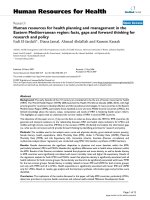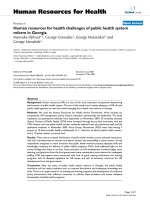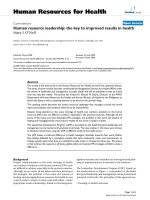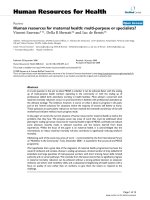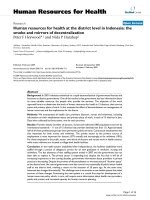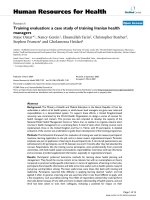Báo cáo sinh học: " Human herpesvirus 6A induces apoptosis of primary human fetal astrocytes via both caspase-dependent and -independent pathways" potx
Bạn đang xem bản rút gọn của tài liệu. Xem và tải ngay bản đầy đủ của tài liệu tại đây (4.44 MB, 21 trang )
This Provisional PDF corresponds to the article as it appeared upon acceptance. Fully formatted
PDF and full text (HTML) versions will be made available soon.
Human herpesvirus 6A induces apoptosis of primary human fetal astrocytes via
both caspase-dependent and -independent pathways
Virology Journal 2011, 8:530 doi:10.1186/1743-422X-8-530
Bin Gu ()
Guo-Feng Zhang ()
Ling-Yun Li ()
Feng Zhou ()
Dong-Ju Feng ()
Chuan-Lin Ding ()
Jing Chi ()
Chun Zhang ()
Dan-Dan Guo ()
Jing-Feng Wang ()
Hong Zhou ()
Kun Yao ()
Wei-Xing Hu ()
ISSN 1743-422X
Article type Research
Submission date 3 August 2011
Acceptance date 12 December 2011
Publication date 12 December 2011
Article URL />This peer-reviewed article was published immediately upon acceptance. It can be downloaded,
printed and distributed freely for any purposes (see copyright notice below).
Articles in Virology Journal are listed in PubMed and archived at PubMed Central.
For information about publishing your research in Virology Journal or any BioMed Central journal, go
to
/>Virology Journal
© 2011 Gu et al. ; licensee BioMed Central Ltd.
This is an open access article distributed under the terms of the Creative Commons Attribution License ( />which permits unrestricted use, distribution, and reproduction in any medium, provided the original work is properly cited.
For information about other BioMed Central publications go to
/>Virology Journal
© 2011 Gu et al. ; licensee BioMed Central Ltd.
This is an open access article distributed under the terms of the Creative Commons Attribution License ( />which permits unrestricted use, distribution, and reproduction in any medium, provided the original work is properly cited.
Human herpesvirus 6A induces apoptosis of
primary human fetal astrocytes via both
caspase-dependent and -independent pathways
ArticleCategory :
Research article
ArticleHistory :
Received: 03-Aug-2011; Accepted: 21-Nov-2011
ArticleCopyright
:
© 2011 Gu et al.; licensee BioMed Central Ltd. This is an Open Access
article distributed under the terms of the Creative Commons Attribution
License ( which permits
unrestricted use, distribution, and reproduction in any medium, provided
the original work is properly cited.
Bin Gu,
Aff1 Aff2
Email:
Guo-Feng Zhang,
Aff1 Aff2
Email:
Ling-Yun Li,
Aff2
Email:
Feng Zhou,
Aff2
Email:
Dong-Ju Feng,
Aff2
Email:
Chuan-Lin Ding,
Aff3
Email:
Jing Chi,
Aff2
Email:
Chun Zhang,
Aff1 Aff2
Email:
Dan-Dan Guo,
Aff2
Email:
Jing-Feng Wang,
Aff2
Email:
Hong Zhou,
Aff2
Email:
Kun
Yao
,
Aff2
Corresponding Affiliation: Aff2
Phone: +86-25-86862901
Email:
Wei-Xing Hu,
Aff1
Corresponding Affiliation: Aff1
Phone: +86-25-68136080
Email:
Aff1
Department of Neurosurgery, First Affiliated Hospital of Nanjing
Medical University, Nanjing 210029, China
Aff2
Department of Microbiology and Immunology, Nanjing Medical
University, Nanjing 210029, China
Aff3
Tumor Immunobiology Program, James Graham Brown Cancer Center,
University of Louisville, Louisville, KY 40202, USA
Abstract
Background
Human herpesvirus 6 (HHV-6) is a T-lymphtropic and neurotropic virus that can infect various
types of cells. Sequential studies reported that apoptosis of glia and neurons induced by HHV-6
might act a potential trigger for some central nervous system (CNS) diseases. HHV-6 is involved
in the pathogenesis of encephalitis, multiple sclerosis (MS) and fatigue syndrome. However, the
mechanisms responsible for the apoptosis of infected CNS cells induced by HHV-6 are poorly
understood. In this study, we investigated the cell death processes of primary human fetal
astrocytes (PHFAs) during productive HHV-6A infection and the underlying mechanisms.
Results
HHV-6A can cause productive infection in primary human fetal astrocytes. Annexin V-PI
staining and electron microscopic analysis indicated that HHV-6A was an inducer of apoptosis.
The cell death was associated with activation of caspase-3 and cleavage of poly (ADP-ribose)
polymerase (PARP), which is known to be an important substrate for activated caspase-3.
Caspase-8 and -9 were also significantly activated in HHV-6A-infected cells. Moreover, HHV-
6A infection led to Bax up-regulation and Bcl-2 down-regulation. HHV-6A infection increased
the release of Smac/Diablo, AIF and cytochrome c from mitochondria to cytosol, which induced
apoptosis via the caspase-dependent and -independent pathways. In addition, we also found that
anti-apoptotic factors such as IAPs and NF-κB decreased in HHV-6A infected PHFAs.
Conclusion
This is the first demonstration of caspase-dependent and -independent apoptosis in HHV-6A-
infected glial cells. These findings would be helpful in understanding the mechanisms of CNS
diseases caused by HHV-6.
Keywords
Apoptosis, Human herpesvirus 6A, Primary human fetal astrocyte, Caspase
Background
Human herpesvirus 6 (HHV-6), a member of the beta herpesvirus family, is a T-lymphotropic
virus and the causal agent of exanthema subitum [1-3]. In recent studies, HHV-6 has been
detected in numerous central nervous system (CNS) diseases including encephalitis, multiple
sclerosis, temporal lobe epilepsy and glioma [4-7]. These findings suggest that HHV-6 may be
associated with some CNS diseases. In vitro, HHV-6 has been shown to infect human glial cells
(microglia, oligodendrocytes and astrocytes) and induce apoptosis [8-10]. However, the
molecular mechanisms of apoptosis induced by HHV-6 in glial cells are not fully understood as
yet.
Apoptosis,a programmed suicide death of cells, which is characterized by chromatin
condensation, DNA fragmentation, membrane blebbing, and cell shrinkage, can occur through
the intrinsic and extrinsic casepase pathways [11]. Caspases, a family of cysteine proteases,
regulate the initiation and the final execution of apoptosis in receptor-mediated and
mitochondria-mediated pathways [12]. In the receptor-mediated pathway, caspase-8 is the
initiator caspase that can directly activate the final executioner caspase-3 [13]. In the
mitochondria-mediated pathway, mitochondria release several pro-apoptotic factors including
cytochrome c, Smac/Diablo, and apoptosis-inducing factor (AIF) into the cytosol [14]. Cytosolic
cytochrome c binds with apoptotic protease activating factor 1 (APAF1) to produce active
caspase-9 and subsequently active caspase-3 for caspase-dependent apoptosis. Samc/Diablo is an
antagonistic protein for inhibitor of apoptosis proteins (IAPs), promotes apoptosis along with
cytochrome c by activating caspases [15]. Mitochondria-mediated apoptosis may also occur in
caspase-independently way after mitochondrial release of AIF that is translocated to the nucleus
for induction of chromatin condensation and DNA fragmentation [16].
In the present study, we investigated the effect and molecular mechanism of HHV-6A inducing
apoptosis in primary human fetal astrocytes (PHFAs). We found that HHV-6A induced apoptosis
in PHFAs through both caspase-dependent and -independent apoptotic pathways. In addition, our
finding also demonstrated that HHV-6A could promote cell death by suppressing IAPs and NF-
κB-mediated anti-apoptosis pathways. To our knowledge, this is the first demonstration of the
mechanisms of apoptosis induced by HHV-6A in astrocytes.
Results
HHV-6A causes productive infection in PHFAs
HHV-6A was used to infect PHFAs at comparable levels of virus DNA (1×10
8
copies/10
6
cells)
as determined by quantitative PCR. HHV-6A-infected PHFAs showed typical cytopathic effects
(CPE) such as cellular swelling and cell fusion at 72 h post-infection (hpi) (Figure 1a). To further
determine HHV-6A infection in PHFAs, the expression of a late protein gp60/110 was analyzed
using immunofluorescence assay and western blotting at 72 hpi. As shown in Figure 1b, a
prominent expression of HHV-6 gp60/110 was detected in HHV-6A-infected PHFAs compared
with that in the control mock-infected cells. The gp60/110 late protein was clearly localized in
the cytoplasm of most multinucleate giant cells. Electron microscopic analyses were also
performed on HHV-6A-infected PHFAs at 72 hpi. As shown in Figure 1c, viral particles could
be visualized in both cytoplasm and extracellular matrix of HHV-6A-infected PHFAs. These
results indicate that HHV-6A can cause productive infection in PHFAs.
Figure 1 HHV-6A causes infection in PHFAs. a. HHV-6A infection exhibited typical cytopathic
effects in infected PHFAs. The morphological characteristics of PHFAs infected with or without
HHV-6A were observed under light microscope. b. HHV-6A-infected PHFAs express viral
gp60/110 protein at 72 h post-infeciton. The gp60/110 protein was determined by IFA and
western blotting with an anti-gp60/110 monoclonal antibody. c. Electron microscopic
photographs of typical herpesvirus-like particles were observed in both cytoplasm and
extracellular matrix of HHV-6A-infected PHFAs.
HHV-6A induces apoptosis of PHFAs
To investigate the effect of HHV-6A infection on apoptosis in PHFAs, cells infected with HHV-
6A were stained with annexin-V-FITC and propidium iodide (PI) after 24, 48, and 72 hpi and
analyzed by flow cytometry. As shown in Figure 2a, we observed a high percentage of annexin-
positive cells (apoptotic cells) in HHV-6A-infected cells at 72 hpi compared to mock-infected
cells. The percentage of early apoptotic cells and late apoptotic cells at 72 hpi reached 5.89% and
17.5% compared to 0.64% and 2.48% in mock-infected cells, respectively. To further confirm
the effect of HHV-6A on cell apoptosis, we also observed the morphologic changes in HHV-6A-
infected cells using transmission electron microscopy. HHV-6A-infected PHFAs showed the
typical features of cell apoptosis: marginalized and condensed chromatin matrix, shrinkage and
blebbing of the cytoplasm and fragmented nuclei (Figure 2b). Virus-like particles could be found
in apoptotic HHV-6A-infected PHFAs (Figure 2c).
Figure 2 HHV-6A infection induces apoptosis of PHFAs. a. Mock- and HHV-6A-infected
PHFAs were stained with annexin V-PI and analyzed by flow cytometry. Percentage of apoptotic
cells was summarized. Each column represents the mean±SD of three independent experiments
(*P <0.05, **P<0.01, ***P<0.001). b. Electron microscopic photographs of mock- and HHV-
6A-infected PHFAs. c. Electron microscopic photographs of virus-like particles in apoptotic
HHV-6A-infected PHFAs
HHV-6A triggers caspases activation
Caspases are synthesized as inactive precursors that are processed to large and small subunits to
form the active enzymes. Caspase-3 is one of the main effective caspases, which are activated in
response to both intracellular and extracellular death signals. To explore the pathway by which
HHV-6A induced apoptosis, we measured caspase-3 activity in HHV-6A-infected PHFAs with
anti-active caspase-3 antibody using flow cytometry. PHFAs with activated caspase-3 were
about 2.81%, 10.12% and 19.31% at 24, 48 and 72 hpi, respectively, whereas the value was only
0.69% in the mock-infected cells (Figure 3a). To further define whether HHV-6A induces
apoptosis via the receptor-mediated or the mitochondria-mediated pathways, the activities of
caspase-8 and -9 were measured, respectively. As shown in Figure 3b,c, HHV-6A infection
resulted in significant increases in caspase-8 and caspase-9 activities at 48 and 72 hpi in HHV-
6A-infected cells compared with mock-infected cells. These data indicate that HHV-6A induce
apoptosis of PHFAs by both the receptor-mediated and the mitochondria-mediated pathways.
Figure 3 HHV-6A triggers caspases activation. a. Mock- and HHV-6A-infected PHFAs were
collected at various time points and the levels of activated caspase-3 were measured by flow
cytometry. b–c. The activation of caspase-8 and caspase-9 was examined by colorimetric method
using lysates from mock-infected and HHV-6A-infected PHFAs. Each column represents the
mean ± SD of three independent experiments (***P<0.001)
HHV-6A activates PARP cleavage and up-regulates bax/bcl-2 ratio
PARP is an established substrate for caspase-3 in the apoptotic events. Cleavage of PARP
facilitates cellular disassembly and serves as a marker of cells undergoing apoptosis. Western
blotting was used to detect endogenous full-length PARP (116KD), as well as the large fragment
(89KD) of PARP resulting from caspase cleavage. As shown in Figure 4a, the 89KD cleaved
fragment of PARP was detected in infected cells at 48 and 72 hpi, but not detected in the mock-
infected cells.
Figure 4 HHV-6A activates PARP cleavage and up-regulates Bax/Bcl-2 ratio. a. PARP in mock-
infected and HHV-6A-infected cells was analyzed by Western blotting. b. Expressions of Bcl-2
and Bax were detected by Western blots using anti-Bcl-2 and anti-Bax antibodies, respectively.
β-actin was used as a loading control. Quantitative values of Bcl-2 and Bax are the mean ± SD
from three independent experiments (**P<0.01, ***P<0.001)
The mitochondria-mediated pathway of apoptosis is regulated by the Bcl-2 family proteins,
which are known to directly regulate mitochondrial membrane permeability. We examined the
levels of expression of Bax (pro-apoptotic) and Bcl-2 (anti-apoptotic) proteins using Western
blotting analysis. As shown in Figure 4b, the levels of Bcl-2 protein were significantly decreased
following HHV-6A infection compared to that in mock-infected cells, whereas the expression of
Bax protein was significantly increased in HHV-6A-infected cells. These results indicate
Bax/Bcl-2 ratio was significantly increased in HHV-6A-infected cells compared with mock-
infected cells.
HHV-6A infection results in the release of pro-apoptotic proteins from
mitochondria
Mitochondria may release several molecules including cytochrome c, Smac/Diablo, and AIF to
induce apoptosis. Mitochondrial cytochrome c release is a well-known pre-condition for
formation of apoptosome and activation of caspases for apoptosis. As shown in Figure 5, there is
a marked increase in the levels of cytochrome c released from mitochondria to cytoplasm at 48
and 72 hpi compared with control. Smac/Diablo plays an important role in apoptosis by down-
regulation anti-apoptotic IAPs. The expression levels of Smac/Diablo were significantly
increased following HHV-6A infection in a time-dependent manner compared to that in mock-
infected cells. In addition, the expression levels of AIF, determining caspase-independent
pathway of apoptosis were also increased obviously in HHV-6A infected cells compared to that
in mock-infected cells. The results suggest that HHV-6A infection in PHFAs can provoke
apoptosis via the mitochondrial intrinsic pathway.
Figure 5 HHV-6A infection results in the release of pro-apoptotic proteins from mitochondria.
Expressions of pro-apoptotic proteins liberated from mitochondria were detected by Western
blots as described in Methods and Materials. β-actin was used as a loading control
HHV-6A suppresses IAPs and NF-κB-mediated anti-apoptosis effect
IAPs are thought to function primarily by negative regulation caspases, which are cysteine
proteases involved in apoptosis. In human cells, IAPs mainly include cIAP1, cIAP2 and XIAP.
As shown in Figure 6, the levels of these three IAPs were significantly decreased in the HHV-
6A-infected cells compared to those in mock-infected cells.
Figure 6 Down-regulation of anti-apoptotic proteins by HHV-6A infection. Representative
Western blots show levels of expression of NF-κB, IκBα, c-IAP1, c-IAP2 and XIAP. β-actin was
used as a loading control
NF-κB plays a crucial role not only in immunity, inflammation and cell migration but also in cell
survival and apoptosis. Many studies confirmed that NF-κB up-regulation and activation exerted
an anti-apoptotic effect leading to cells survival, transformation, and resistance to radiation and
chemotherapy [17]. As shown in Figure 6, the levels of NF-κB were significantly decreased in
HHV-6A-infected cells compared to that in mock-infected cells, while the expression of NF-κB
inhibitor – IκBα protein was significantly increased in HHV-6A-infected cells. These results
indicate that HHV-6A infection injures IAPs and NF-κB-mediated anti-apoptosis signal
pathways in PHFAs.
Discussion
HHV-6 was first isolated from peripheral blood mononuclear cells of patients with
lymphoproliferative disorders and AIDS [2]. There are two variants of HHV-6 (A and B)
according to distinct genetic, immunological and virological characteristics [18]. As with other
virus, HHV-6 is able to induce apoptosis of host cells. Subsequent studies have demonstrated
that HHV-6 has been shown to induce apoptosis in astrocytes, oligodendrocytes, neuronal cell
lines and CD4
+
T lymphocytes [8,19,20]. Gardell et al. [8] reported that HHV-6A induced
apoptosis by an unknown mechanism in astrocytes, oligodendrocytes and neuronal cell lines.
Inoue et al. [20] demonstrated that TNF-α and anti-Fas antibodies augmented HHV-6-induced
apoptosis, suggesting an involvement bof death receptors in HHV-6-induced apoptosis. In
contrast, Inchimi et al. [21] found that HHV-6 induced apoptosis of cord blood lymphocytes
through a receptor-independent pathway.
Caspases play a critical role in apoptosis, which cleave specific substrates and activate
downstream molecules and culminate in cell death [11,13]. However, the roles of caspases in
HHV-6-induced apoptosis of astrocytes haven’t been studied yet. In this study, we demonstrated
that the activities of caspase-3, -8 and -9 were all increased in HHV-6A-induced apoptosis of
PHFAs. In addition, we found that PARP was cleaved in HHV-6A-induced apoptotic PHFAs.
Caspase-3 is a common effector of both death receptor and the mitochondrial signaling
pathways. Caspase-8 is activated by the death receptor signaling pathway, whereas caspase-9 is
activated in the mitochondrial signaling pathway during apoptosis. We speculate that HHV-6A-
induced apoptosis in astrocytes via both caspase-dependent receptor and mitochondrial apoptotic
pathways.
Bcl-2 family proteins are central regulators of the mitochondrial apoptotic pathway and have
been implicated in various models of virus-induced apoptosis. Pugazhenthi et al. [22] found that
simian varicella virus induced apoptosis in monkey kidney cells via caspase-dependent
mitochondrial pathway and involves down-regulation of bcl-2 expression. The translocation and
accumulation of Bax, a pro-apoptotic factor of Bcl-2 family in mitochondria will lead to release
of cytochrome c and AIF [23]. We examined the expression of Bcl-2 and Bax in HHV-6A-
induced mitochondrial dysfunction. Our data showed that the anti-apoptotic protein Bcl-2
decreased, which was accompanied by the increase of pro-apoptotic protein Bax during HHV-6A
infection, suggesting that Bcl-2 and Bax were involved in the apoptosis of HHV-6A-infected
PHFAs.
Up-regulation of Bax induces the permeabilization of mitochondrial outer membrane and
initiates mitochondrial dysfunction. Mitochondria may release several molecules including
cytochrome c, Smac/Diablo, and AIF to induce apoptosis via the caspase-dependent and -
independent pathways [24-26]. We separated the cytosolic and mitochondrial fractions to
examine the cytochrome c levels by Western blotting and found a marked increase in
cytochrome c level in the cytosolic fraction due to a concomitant decrease in the cytochrome c
level in the mitochondrial fraction following HHV-6A infection. Mitochondrial cytochrome c
releases into cytoplasm to bind to the apoptosis protease activation factor (APAF1) and to form a
complex of apoptosome activating pro-caspase 9. The activation of pro-caspase 9 initiates an
enzymatic reaction cascade leading to the execution of apoptosis in cells [27]. We also observed
a time-dependent increase the cytosolic level of Smac/Diablo following infection compared with
control cells. Smac/Diablo can inhibit inhibitor-of-apoptosis-proteins (IAPs), which otherwise
inactivate caspases [28]. Mitochondria-mediated apoptosis may also occur caspase-
independently after mitochondrial release of AIF and Endo G which are translocated to the
nucleus for induction of chromatin condensation and DNA fragmentation. Our investigation
demonstrated that HHV-6A markedly increased the cytosolic level of AIF in PHFAs, indicating
involvement of caspase-independent pathway of apoptosis [29].
In addition, NF-κB reportedly induces the expression of c-IAP1, c-IAP2 and XIAP, thereby
promoting NF-κB activation in a positive feed-back system [30]. NF-κB up-regulation exerts an
anti-apoptotic effect leading to cells survival, transformation, and resistance to radiation and drug
therapies [31]. In contrast, NF-κB down-regulation will break this feed-back loop and reduce the
expression of c-IAP1, c-IAP2 and XIAP, which are the direct caspase inhibitors. In the present
study, we found that HHV-6A decreased NF-κB and increased Iκ-Bα expression in time-
dependent manners. IκBα is one member of the family of cellular proteins that function to inhibit
the activity of NF-κB. IκBα inhibits NF-κB by masking the nuclear localization signals of NF-
κB proteins and keeping them sequestered in an inactive state in the cytoplasm. IκBα up-
regulation may inhibit the activity of NF-κB which was observed down-regulation in HHV-6A-
infected PHFAs. We also found that HHV-6A decreased expression of c-IAP1, c-IAP2 and
XIAP. Increased mitochondrial release of Smac/Diablo could antagonize IAPs expression.
Suppression of survival factors such as IAPs and NF-κB could be due to cytosolic up-regulation
of Smac/Diablo [17].
Conclusion
We demonstrated that HHV-6A induces cell apoptosis in PHFAs through both caspase-
dependent and -independent apoptosis pathways, as evidenced by (1) activation of caspase-3, -8
and -9; (2) increasing the ratio of Bax/Bcl-2; (3) increasing the presence of Smac/Diablo, AIF
and cytochrome c in cytoplasm; (4) down-regulation of anti-apoptotic NF-κB and IAPs. The
identification of the apoptotic signaling pathways in HHV-6A-infected PHFAs would be very
helpful in understanding the mechanisms by which HHV-6A infection causes diseases in the
CNS.
Materials and methods
Cells and viruses
The primary human fetal astrocytes (Sciencell) were cultured in DEME/F12 (Hyclone)
supplemented with 10% fetal calf serum, 100 IU/ml penicillin/streptomycin (Invitrogen). Human
T-cell line HSB-2 cells were cultured in RPMI 1640 medium containing 8% fetal calf serum.
HHV-6A strain GS was inoculated into HSB-2 cells. The cells were frozen and thawed twice
when 80% of HHV-6A-infected HSB-2 cells showed the cytopathic effects (CPE), then
centrifuged at 2000×g for 10 min. The supernatants were stored at −70°C as cell-free virus. Viral
DNA equivalents of the frozen aliquot were tested by quantitative PCR. Uninfected HSB-2 cells
were similarly cultured and treated using the same procedure and used for mock infection. For
infection, 3×10
5
primary human fetal astrocytes (PHFAs) were seeded onto a poly-L-lysine
(Sigma)-coated 25-cm2 flask (Corning). After an overnight incubation, the plate was washed
three times with phosphate-buffered saline (PBS) and infected with cell-free supernatant
containing 10
8
viral DNA copies/10
6
PHFAs. After 3 h incubation at 37°C in 5% CO
2
, cultures
were washed three times with PBS, and fresh medium was added. The HHV-6A-infected cells
were checked for CPE every day in microscopy. Procedures for mock infection were performed
in the same manner as for viral infection.
Immunofluorescence assay (IFA)
PHFAs were cultured on poly-L-lysine-coated 2-chamber glass slides, and the infection was
performed as described above. The procedure of immunofluorescence assay has previously been
described [32]. Briefly, PHFAs infected with or without HHV-6A were fixed in 4%
paraformaldehyde (in PBS), permeabilized in 0.5% Triton X-100 (in PBS), and stained with the
anti-gp60/110 monoclonal antibodies (Chemicon international) followed by secondary antibody
labeled with fluorescein isothiocyanate (FITC).
Electron microscopy
Cells were fixed with 2.5% glutaradehyde at room temperature for 1 h. After washing with PBS,
the cells were collected, dehydrated in a series of 70%, 80% and 90% ethanol, and embedded in
Epon. Ultrathin sections were cut and mounted in nickel grids, stained with uranyl acetate and
lead citrate, and examined by a transmission electron microscopy.
Annexin V-propidium iodide (PI) staining
Apoptosis was measured by Annexin V-propidium iodide (PI) staining and flow cytometry.
Infected and uninfected PHFAs were trypsinized, washed in PBS and incubated with Annexin V-
FITC and PI solution (Bender MedSystems, Burlingame) in the dark for 15 min. Samples were
analyzed by flow cytometry with FACSCalibur and BD CellQuest Pro software (Becton
Dickinson, Mountain View). The amount of early apoptosis and late apoptosis was determined as
the percentage of Annexin V
+
/PI
-
and Annexin V
+
/PI
+
, respectively.
Analysis of activated caspase-3 by flow cytometry
Caspase-3 activities in HHV-6A-infected and mock-infected PFHA were tested by flow
cytometry with FITC-DEVD-FMK that recognizes cleaved caspase-3 according to the protocol
by the manufacturer (Biovision Inc.).
Analysis of caspase-8 and caspase-9 using a colorimetric method
The activation of caspase-8 and caspase-9 was analyzed using a colorimetric assay kit
(KeyGEN). Briefly, mock-infected and HHV-6A-infected PFHA were collected and resuspended
in 50 µl of lysis buffer and incubated on ice for 30 min. After centrifugation, the protein
concentration was assayed by the BCA Protein Assay kit (Byotime), and 50 µg protein was
diluted in 50 µl lysis buffer for each assay. Then 5 µl of casepase-8 or caspase-9 substrate were
added, respectively. The reaction mixture was incubated at 37°C for 4 h. The released
chromphore was measured at 405 nm by a microplate reader.
Preparation of cytosolic and mitochondrial extracts
Cells were washed twice with PBS and kept for 1 h in ice-cold hypotonic buffer (20 mM
HEPES, pH7.4, 1.5 mM MgCl2, 10 mM KCl, 1 mM EDTA, 1 mM EGTA, 1 mM dithiothreitol,
1 mM phenylmethylsulfonyl fluoride, 10 µg/ml leupeptin, aprotinin and pepstatin) containing
250 mM sucrose. The cells were homogenized using a Dounce homogenizer (KONTES), and
cytosolic and mitochondrial extracts were isolated as described previously [33].
Western blotting
Cells were lysed with a lysis buffer containing 50 mmol/L Tris (pH7.4), 0.5%NP-40, 0.01% SDS
and a cocktail of protease inhibitors. Equal amounts of protein (30 µg) estimated by the BCA
Protein Assay kit (Byotime) were separated by electrophoresis on 10% polyacrylamide gel and
transferred to a PDVF membrane (Millipore). After blocking for 1 hour with 5% nonfat dry milk
in TBST buffer containing 50 mmol/L Tris–HCl, 150 mmol/L NaCl and 0.1% Tween 20 (pH7.6)
at room temperature, the blots were incubated overnight at 4°C with the specific primary
antibody. Primary antibodies used were β-actin, IκBα, NF-κB, XIAP, c-IAP1, c-IAP2,PARP,
AIF, Cytochrome c and Samc/Diablo (Cell Signaling Technology), Bax and Bcl-2 (Bioworld).
Membranes were subsequently incubated with horseradish peroxidase-conjugated secondary
antibody (Santa Cruz Biotechnology) for 1 h at room temperature and developed using a
chemiluminescent (ECL) reagent (Applygen Technologies). The results were scanned using Gel
Imaging System (UVP Company) and measured using Gel-Pro Analyzer software (Media
Cybernetics).
Statistical analysis
Data were presented as means ± SD. One-way ANOVA followed by LSD post-hoc test was used
to assess the statistical significance of differences between groups. A value of P<0.05 was
considered to be statistically significant.
Abbreviations
HHV-6: Human herpesvirus 6; CNS: Central nervous system; MS: Multiple sclerosis; AIDS:
Acquired immunodeficiency syndrome; PHFA: Primary human fetal astrocyte; Bax: Bcl-2
associated X protein; Bcl-2: B cell lymphoma 2; AIF: Apoptosis-inducing factor; APAF1:
Apoptotic protease activating factor 1; IAP: Inhibitor of apoptosis protein; IκBα: Nuclear factor
of kappa light polypeptide gene enhancer in B-cells inhibitor, alpha; NF-κB: Nuclear factor
kappa B; CPE: Cytopathic effect; hpi: Hours post-infection; PARP: Poly (ADP-ribose)
polymerase; TNF- α: Tumor necrosisfactor-alpha; PI: Propidium iodide; PBS: Hosphate-buffered
saline
Competing interests
The author(s) declare that they have no competing interests.
Authors’ contributions
BG, KY and WXH designed and directed studies, and were involved in the interpretation of the
data and writing of manuscript. BG, GFZ and FZ carried out the cells culture and HHV-6
infection. BG, JFW and LYL participated in immunofluorescence assay and the western blot
analysis. BG, DJF and CZ performed the flow-cytometry experiments. BG, JC and DDG
performed the analysis of Caspase-8 and -9 activities and electron microscopy. CLD and HZ
helped to modifiy the manuscript. All authors read and approved the final manuscript.
Acknowledgements
This work was supported by a Grant from the National Natural Science Foundation of China
(No. 30972784).
References
1. Yamanishi K, Okuno T, Shiraki K, Takahashi M, Kondo T, Asano Y, Kurata T: Identification
of human herpesvirus-6 as a causal agent for exanthem subitum. Lancet 1988,
1(8594):1065–1067.
2. Salahuddin SZ, Ablashi DV, Markham PD, Josephs SF, Sturzenegger S, Kaplan M, Halligan
G, Biberfeld P, Wong-Staal F, Kramarsky B et al: Isolation of a new virus, HBLV, in patients
with lymphoproliferative disorders. Sci 1986, 234(4776):596–601.
3. Takahashi K, Sonoda S, Higashi K, Kondo T, Takahashi H, Takahashi M, Yamanishi K:
Predominant CD4 T-lymphocyte tropism of human herpesvirus 6-related virus. J Virol
1989, 63(7):3161–3163.
4. Yoshikawa T: [Human herpesvirus 6 encephalitis]. Brain Nerve 2010, 62(8):869–875.
5. Niehusmann P, Mittelstaedt T, Bien CG, Drexler JF, Grote A, Schoch S, Becker AJ: Presence
of human herpes virus 6 DNA exclusively in temporal lobe epilepsy brain tissue of patients
with history of encephalitis. Epilepsia 2010, 51(12):2478–2483.
6. Kakalacheva K, Munz C, Lunemann JD: Viral triggers of multiple sclerosis. Biochim
Biophys Acta 2011, 1812(2):132–140.
7. Crawford JR, Santi MR, Thorarinsdottir HK, Cornelison R, Rushing EJ, Zhang H, Yao K,
Jacobson S, Macdonald TJ: Detection of human herpesvirus-6 variants in pediatric brain
tumors: association of viral antigen in low grade gliomas. J Clin Virol 2009, 46(1):37–42.
8. Gardell JL, Dazin P, Islar J, Menge T, Genain CP, Lalive PH: Apoptotic effects of Human
Herpesvirus-6A on glia and neurons as potential triggers for central nervous system
autoimmunity. J Clin Virol 2006, 37(Suppl 1):S11-16.
9. Albright AV, Lavi E, Black JB, Goldberg S, O’Connor MJ, Gonzalez-Scarano F: The effect
of human herpesvirus-6 (HHV-6) on cultured human neural cells: oligodendrocytes and
microglia. J Neurovirol 1998, 4(5):486–494.
10. He J, McCarthy M, Zhou Y, Chandran B, Wood C: Infection of primary human fetal
astrocytes by human herpesvirus 6. J Virol 1996, 70(2):1296–1300.
11. Kurokawa M, Kornbluth S: Caspases and kinases in a death grip. Cell 2009, 138(5):838–
854.
12. Green DR, Reed JC: Mitochondria and apoptosis. Sci 1998, 281(5381):1309–1312.
13. Kumar S, Vaux DL: Apoptosis. A cinderella caspase takes center stage. Sci 2002,
297(5585):1290–1291.
14. Danial NN, Korsmeyer SJ: Cell death: critical control points. Cell 2004, 116(2):205–219.
15. Verhagen AM, Ekert PG, Pakusch M, Silke J, Connolly LM, Reid GE, Moritz RL, Simpson
RJ, Vaux DL: Identification of DIABLO, a mammalian protein that promotes apoptosis by
binding to and antagonizing IAP proteins. Cell 2000, 102(1):43–53.
16. Jin Z, El-Deiry WS: Overview of cell death signaling pathways. Cancer Biol Ther 2005,
4(2):139–163.
17. Gyrd-Hansen M, Meier P: IAPs: from caspase inhibitors to modulators of NF-kappaB,
inflammation and cancer. Nat Rev Cancer 2010, 10(8):561–574.
18. Safronetz D, Humar A, Tipples GA: Differentiation and quantitation of human
herpesviruses 6A, 6B and 7 by real-time PCR. J Virol Methods 2003, 112(1–2):99–105.
19. Yasukawa M, Inoue Y, Ohminami H, Terada K, Fujita S: Apoptosis of CD4+ T
lymphocytes in human herpesvirus-6 infection. J Gen Virol 1998, 79 (Pt 1):143–147.
20. Inoue Y, Yasukawa M, Fujita S: Induction of T-cell apoptosis by human herpesvirus 6. J
Virol 1997, 71(5):3751–3759.
21. Ichimi R, Jin-no T, Ito M: Induction of apoptosis in cord blood lymphocytes by HHV-6. J
Med Virol 1999, 58(1):63–68.
22. Pugazhenthi S, Gilden DH, Nair S, McAdoo A, Wellish M, Brazeau E, Mahalingam R:
Simian varicella virus induces apoptosis in monkey kidney cells by the intrinsic pathway
and involves downregulation of bcl-2 expression. J Virol 2009, 83(18):9273–9282.
23. Desagher S, Osen-Sand A, Nichols A, Eskes R, Montessuit S, Lauper S, Maundrell K,
Antonsson B, Martinou JC: Bid-induced conformational change of Bax is responsible for
mitochondrial cytochrome c release during apoptosis. J Cell Biol 1999, 144(5):891–901.
24. Caroppi P, Sinibaldi F, Fiorucci L, Santucci R: Apoptosis and human diseases:
mitochondrion damage and lethal role of released cytochrome C as proapoptotic protein.
Curr Med Chem 2009, 16(31):4058–4065.
25. Yoon K, Jang HD, Lee SY: Direct interaction of Smac with NADE promotes TRAIL-
induced apoptosis. Biochem Biophys Res Commun 2004, 319(2):649–654.
26. Artus C, Boujrad H, Bouharrour A, Brunelle MN, Hoos S, Yuste VJ, Lenormand P,
Rousselle JC, Namane A, England P et al: AIF promotes chromatinolysis and caspase-
independent programmed necrosis by interacting with histone H2AX. EMBO J 2010,
29(9):1585–1599.
27. Cagnol S, Mansour A, Van Obberghen-Schilling E, Chambard JC: Raf-1 activation
prevents caspase 9 processing downstream of apoptosome formation. J Signal Transduct
2011, 2011:834948.
28. Adrain C, Creagh EM, Martin SJ: Apoptosis-associated release of Smac/DIABLO from
mitochondria requires active caspases and is blocked by Bcl-2. EMBO J 2001, 20(23):6627–
6636.
29. Sarmento L, Tseggai T, Dhingra V, Fu ZF: Rabies virus-induced apoptosis involves
caspase-dependent and caspase-independent pathways. Virus Res 2006, 121(2):144–151.
30. Richter BW, Duckett CS: The IAP proteins: caspase inhibitors and beyond. Sci STKE
2000, 2000(44):pe1.
31. Aydin C, Sanlioglu AD, Bisgin A, Yoldas B, Dertsiz L, Karacay B, Griffith TS, Sanlioglu S:
NF-kappaB targeting by way of IKK inhibition sensitizes lung cancer cells to adenovirus
delivery of TRAIL. BMC Cancer 2010, 10:584.
32. Li L, Gu B, Zhou F, Chi J, Wang F, Peng G, Xie F, Qing J, Feng D, Lu S et al.: Human
Herpesvirus 6 Suppresses T Cell Proliferation through Induction of Cell Cycle Arrest in
Infected Cells in the G2/M Phase. J Virol 2011, 85(13):6774–6783.
33.
Malla R, Gopinath S, Alapati K, Gondi CS, Gujrati M, Dinh DH, Mohanam S, Rao JS: Downregulation of uPAR and cathepsin B
induces apoptosis via regulation of Bcl-2 and Bax and inhibition of the PI3K/Akt pathway in gliomas. PLoS One 2010, 5: e13731.
